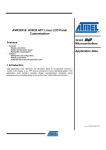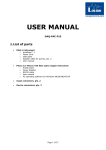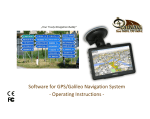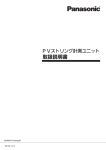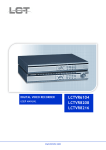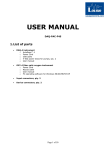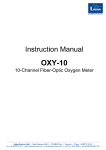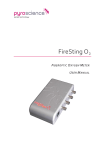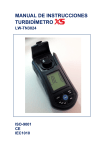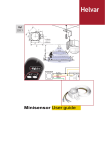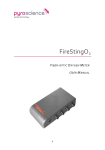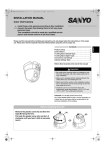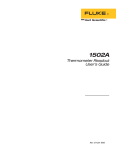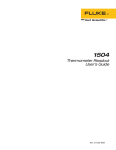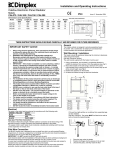Download LP-1 Control Panel - PreSens Precision Sensing GmbH
Transcript
PreSens Precision Sensing GmbH Instruction Manual Control panel LP-1 v2 Manual Version 5 PreSens Precision Sensing GmbH Control panel LP-1 v2 LCD&Data-logger Unit PC Software Version LCDLP1v105 June 2007 Specification: Control panel with graphical LCD and integrated Data-logger for oxygen and trace oxygen meters. PC control of the LCD&Data-logger Unit is available. Manufacturer: PreSens Precision Sensing GmbH Josef-Engert-Straße 11 D-93053 Regensburg Germany Phone: Fax: Email: Internet: Date: 18 June 2007 +49 941 942 72 100 +49 941 942 72 111 [email protected] www.presens.de Filename: 70618_LP1v2_UM5 Table of contents 2 Table of contents Control panel ..........................................................................................................................3 1.1 Compatibility ...........................................................................................................3 1.2 Starting the instrument ..........................................................................................3 1.3 Setting measurement parameters.........................................................................6 1.4 Calibration ...............................................................................................................7 1.4.1 1.4.2 1.4.3 Calibration standards for the respective oxygen sensors ............................................................ 8 Calibration of the PSt1 and PSt3 oxygen sensors..................................................................... 10 Calibration of the PSt6 oxygen sensor ...................................................................................... 11 1.5 Sensor type ...........................................................................................................13 1.6 Data logging ..........................................................................................................13 1.7 Configuration ........................................................................................................15 1.8 Technical data.......................................................................................................17 1.9 Menu structure......................................................................................................18 3 Control panel Control panel The control panel LP-1 is a device to control several PreSens oxygen and trace oxygen meters without the need to connect the oxygen meters to PC. The LP-1 supports the oxygen meters Microx TX3, Fibox 3 and Fibox 3-trace v3. It is also possible to store up to 26150 readings into the internal memory of the control panel. For readout of stored data a connection to a PC and the use of the PC software LCDLP1 is necessary. 1.1 Compatibility The control panel LP-1 supports the following oxygen meters with three versions of oxygen sensor as displayed in the chart below. oxygen meter and sensor compatibility of the LP-1 v2 sensor PSt1 PSt3 oxygen meter PSt6 Fibox 3 (FW 3.016) ▬ X ▬ Fibox 3-trace v3 (FW 3.025) ▬ X X Microx TX3 (FW 3.016) X ▬ ▬ Oxygen meters with other firmware version or not listed types are not compatible. If a supported device shows ‘Device type’ on the Display from the control panel, please contact our service team for help and further information’s! 1.2 Starting the instrument Connect the delivered cables on the backside between the instrument and the control panel LP-1 as shown in picture 1 (12 VDC cable left and RS232 cable rightmost). Then connect the respectively power supply (send by oxygen instrument) into the control panel and attach the temperature sensor and oxygen sensor to the instrument. Picture 1: Connection between control panel and oxygen instrument Control panel Switch on the instrument by pressing the button on the right side (pic 2): Picture 2: Topside control panel The instrument starts to measure with the settings of the last measurements. By pressing VIEW (second button from left) you can choose between three different views: 1st VIEW: 4 5 Control panel 2nd VIEW: 3rd VIEW: Actual oxygen value Maximum oxygen value Actual oxygen value Ongoing graph Status of temperature Minimum oxygen value Selected sampling rate x 5 times 6 Control panel 1.3 Setting measurement parameters Press the MENU button to enter the main menu: Main Menu Measurement Calibration Data logging Configuration Back Enter Use the up and down buttons to select. Press MEASUREMENT to enter the Measurement mode: Measurement Sampling Temperature Pressure Signal averaging Oxygen units Sig. intensity Back Enter Use the up and down buttons to select. Press ENTER to change the respective settings: Control panel Sampling rate: Press edit to change sampling rate and adjust the desired sampling rate. Use the up and down buttons to select the respective unit and confirm by pressing enter. Note! The minimum sampling rate from devices which are connected to the Control Panel LP-1 is 2 sec! Temperature: Press edit to change the temperature compensation: Pt 1000 means temperature compensation with the delivered Temperature sensor Manual allows the manual input of a constant temperature; Use the up and down buttons to select the desired temperature and confirm by pressing enter Pressure: Disabled – please contact our service for this function! Signal averaging: Press edit to change Signal Averaging Auto: The instrument itself chooses the best settings Manual The higher the running average, the longer the time (sampling time) used for averaging. The higher the running average is set, the smoother the measurement signal Oxygen units: Press edit to change the oxygen unit displayed. Use the up and down buttons to select the respective unit and confirm by pressing enter. Sig. Intensity: Press edit to change the intensity of the signal LED. Please notice that your calibration is not valid after changing this parameter! Use the + and – button to adjust and press SET to confirm the settings. Values between 5 and 100 % are possible. 1.4 Calibration Press ‘Status‘ to display the settings of your last calibration. You can press any button to return to the main menu. Press ‘Calibrate‘ to enter the calibration procedure. Choose the calibration mode: a)Temperature ON means calibration with the actual temperature reading (either Pt1000, external or manual which is defined under Measurement – Temperature). b)Temperature OFF means calibration with the manual input of temperature c)Manual means manual input of phase and temperature values 7 Control panel 1.4.1 8 Calibration standards for the respective oxygen sensors • PSt1 type oxygen sensor Calibration of oxygen microsensors (sensor type PSt1 compatible to Microx TX3 oxygen meter) is performed using a conventional two-point calibration in oxygen-free water (cal 0) and water vapor-saturated air or air-saturated water (cal 100). Preparation of calibration solution 0 (oxygen-free water): 1. Add 1 g sodium sulfite (Na2SO3) to the vessel and label it cal 0. 2. Dissolve Na2SO3 in 100 mL water. The water becomes oxygen-free due to a chemical reaction of oxygen with Na2SO3. Additional oxygen, diffusing from air into the water, is removed by surplus of Na2SO3. 3. Close the vessel with a screw top and shake it for approximately one minute to dissolve Na2SO3 and to ensure that the water is oxygen-free. Keep the vessel closed after calibration with a screw top to minimize oxygen contamination. To prepare oxygen-free water you also can use sodium dithionit (Na2S2O4). The shelf life of cal 0 is about 24 hours provided that the vessel has been closed with the screw top. As alternative you can also use pure nitrogen gas (5.0) to adjust the cal0 calibration value. Preparation of calibration standard 100 (water-vapor saturated air) 1. Place wet cotton wool in a vessel and label it cal 100. 2. Drill two holes for inserting the minisensor and the temperature sensor in the screw top and close the vessel. 3. Wait about 2 minutes to ensure that the air is water vapor-saturated Alternative preparation of calibration standard 100 (air-saturated water) 1. Add 100 mL water to a suitable vessel and label it cal 100. 2. To obtain air-saturated water, blow air into the water using an air-pump with a glass-frit (airstone), creating a multitude of small air bubbles, while stirring the solution. 3. After 20 minutes, switch off the air-pump and stir the solution for further 10 minutes to ensure that the water is not supersaturated. Control panel 9 • PSt3 type oxygen sensor Calibration of oxygen minisensors (sensor type PSt3 compatible to Fibox 3 or Fibox 3-Trace v3 oxygen meter) is performed using a conventional two-point calibration in oxygen-free water (cal 0) and water vapor-saturated air or air-saturated water (cal 100). Preparation of calibration solution 0 (oxygen-free water): 1. Add 1 g sodium sulfite (Na2SO3) to the vessel and label it cal 0. 2. Dissolve Na2SO3 in 100 mL water. The water becomes oxygen-free due to a chemical reaction of oxygen with Na2SO3. Additional oxygen, diffusing from air into the water, is removed by surplus of Na2SO3. 3. Close the vessel with a screw top and shake it for approximately one minute to dissolve Na2SO3 and to ensure that the water is oxygen-free. Keep the vessel closed after calibration with a screw top to minimize oxygen contamination. To prepare oxygen-free water you also can use sodium dithionit (Na2S2O4). The shelf life of cal 0 is about 24 hours provided that the vessel has been closed with the screw top. As alternative you can also use pure nitrogen gas (5.0) to adjust the cal0 calibration value. Preparation of calibration standard 100 (water-vapor saturated air) 4. Place wet cotton wool in a vessel and label it cal 100. 5. Drill two holes for inserting the minisensor and the temperature sensor in the screw top and close the vessel. 6. Wait about 2 minutes to ensure that the air is water vapor-saturated Alternative preparation of calibration standard 100 (air-saturated water) 4. Add 100 mL water to a suitable vessel and label it cal 100. 5. To obtain air-saturated water, blow air into the water using an air-pump with a glass-frit (airstone), creating a multitude of small air bubbles, while stirring the solution. 6. After 20 minutes, switch off the air-pump and stir the solution for further 10 minutes to ensure that the water is not supersaturated. • PSt6 type trace oxygen sensor Calibration of trace oxygen minisensors PSt6 (compatible to Fibox 3-trace v3 oxygen meter) is performed using a conventional two-point calibration in a nitrogen-saturated atmosphere (nitrogen 5.0) (cal 0) and a second calibration value, optimally in the range between 5 and 10 % air-saturation (ca. 1 and 2 % pure oxygen). The second calibration value may be adjusted via a gas mixing device or with a commercially available test gas. Please use humidified gases e.g. by bubbling the gases through a washing bottle with a frit. Control panel 1.4.2 • 10 Calibration of the PSt1 and PSt3 oxygen sensors Calibration with temperature compensation: 1. Choose Temperature ON in calibration menu; 2. Adjust the atmospheric pressure by using the ‘+’ and ‘–‘ button. Confirm the atmospheric pressure by pressing the ‘Set’ button; 3. Please insert the sensor in the Cal0 calibration solution (sodium sulfite) or cal0 calibration gas (nitrogen 5.0); Please have a look in the user manual for details of the calibration process of the respective sensor! 4. Wait about 3 minute until the phase angle and the temperature value is constant (the variation of the phase angle and the temperature should be smaller than ± 0.05° and 0.1. Press the ‘STORE’ button. 5. Please insert the sensor (PSt1, PSt3) into the cal100 calibration solution (airsaturated water) or cal100 gas (humidified air). Please have a look in the user manual for details of the calibration process of the respective sensor! 6. Wait about 3 minute until the phase angle and the temperature value is constant (the variation of the phase angle and the temperature should be smaller than ± 0.05° and 0.1. Press the ‘STORE’ button. The calibration with temperature control is finished. • Calibration without temperature compensation: 1. Choose Temperature OFF in calibration menu; 2. Adjust the atmospheric pressure by using the ‘+’ and ‘–‘ button. Confirm the atmospheric pressure by pressing the ‘Set’ button; 3. Adjust the calibration temperature by using the ‘+’ and ‘–‘ button. Confirm the calibration temperature by pressing the ‘Set’ button; 4. Please insert the sensor in the Cal0 calibration solution (sodium sulfite) or cal0 calibration gas (nitrogen 5.0); Please have a look in the user manual for details of the calibration process of the respective sensor! 5. Wait about 3 minute until the phase angle is constant (the variation of the phase angle should be smaller than ± 0.05°. Press the ‘STORE’ button. 6. Please insert the sensor (PSt1, PSt3) into the cal100 calibration solution (airsaturated water) or cal100 gas (humidified air). In case you are calibration a trace oxygen sensor PSt6 please use a gas mixture between 1 and 2 % oxygen. Please have a look in the user manual for details of the calibration process of the respective sensor! 7. Wait about 3 minute until the phase angle is constant (the variation of the phase angle should be smaller than ± 0.05°. Press the ‘STORE’ button. The calibration without temperature control is finished. Control panel • 11 Manual temperature compensation: A manual calibration should be applied, if you don't want to calibrate your sensor again. However, this is only possible if you already know the calibration values of the special sensor. PreSens GmbH delivers an inspection sheet with each oxygen sensor where you can find two calibration values, which you have to enter in the manual calibration mode. 1. Choose Manual in calibration menu; Please have a look in the user manual for details of the calibration process of the respective sensor! 2. Enter the cal0 phase angle (first calibration value, provided on the inspection sheet) by using the ‘+’ and ‘–‘ button. Confirm the cal0 phase angle of the 1st calibration point by pressing the ‘Set’ button; 3. Adjust the cal100 phase angle (second calibration value, provided on the inspection sheet) by using the ‘+’ and ‘–‘ button. Confirm the cal100 phase angle of the 2nd calibration point by pressing the ‘Set’ button; 4. Adjust the calibration temperature of the first calibration value (provided on the inspection sheet) by using the ‘+’ and ‘–‘ button. Confirm the calibration temperature by pressing the ‘Set’ button; 5. Adjust the calibration temperature of the second calibration value (provided on the inspection sheet) by using the ‘+’ and ‘–‘ button. Confirm the calibration temperature by pressing the ‘Set’ button; 6. Adjust the atmospheric pressure (provided on the inspection sheet) by using the ‘+’ and ‘–‘ button. Confirm the atmospheric pressure by pressing the ‘Set’ button; The manual calibration process is finished. 1.4.3 Calibration of the PSt6 oxygen sensor Please have a look in the user manual for details of the calibration process of the respective sensor type! • Calibration with temperature compensation 1. To calibrate the trace oxygen sensor with temperature compensation adjust sensor type PSt6 in the calibration menu under ‘sensor type’ 2. Press in the ‘Calibrate’ menu the button ‘temperature on’ 3. Adjust the atmospheric pressure and confirm it by pressing the ‘Set’ button 4. Adjust the concentration of the second calibration gas in % air-saturation (e.g. 2 % oxygen = 2/20.95*100 % air-sat. = 9.55 % air-sat.)and confirm it by pressing the ‘Set’ button 5. Please insert the sensor and the temperature sensor in the cal0 calibration standard. Please ensure, not to create an overpressure and that no traces of oxygen can diffuse into your measuring system. 6. Wait about 5 minutes until the phase angle and temperature are constant (the variation of the phase angle and the temperature should be smaller than ± 0.05° and ± 0.1°C) and press the ‘Store’ button. 7. Please insert the sensor and the temperature sensor in the second calibration standard. Please ensure, not to create an overpressure or to contaminate your calibration chamber with air. Control panel 12 8. Wait about 5 minutes until the phase angle and temperature are constant (the variation of the phase angle and the temperature should be smaller than ± 0.05° and ± 0.1°C) and press the ‘Store’ button. 9. Now, calibration is complete. Protect the oxygen sensor with the delivered protective plastic cover. • Calibration without temperature compensation 1) To calibrate the trace oxygen sensor without temperature compensation adjust sensor type PSt6 in the calibration menu under ‘sensor type’; 2) Press in the ‘Calibrate’ menu the button ‘temperature off’; 3) Adjust the temperature of the calibration standards and confirm it by pressing the ‘Set’ button; 4) Adjust the atmospheric pressure and confirm it by pressing the ‘Set’ button; 5) Adjust the concentration of the second calibration gas in % air-saturation (e.g. 2 % oxygen = 2/20.95*100 % air-sat. = 9.55 % air-sat.) and confirm it by pressing the ‘Set’ button 6) Please insert the sensor in the cal0 calibration standard. Please ensure, not to create an overpressure and that no traces of oxygen can diffuse into your measuring system. 7) Wait about 5 minutes until the phase angle and temperature are constant (the variation of the phase angle should be smaller than ± 0.05°) and press the ‘Store’ button. 8) Please insert the sensor in the second calibration standard. Please ensure, not to create an overpressure or to contaminate your calibration chamber with air. 9) Wait about 5 minutes until the phase angle and temperature are constant (the variation of the phase angle should be smaller than ± 0.05°) and press the ‘Store’ button. 10) Now, calibration is complete. Protect the oxygen sensor with the delivered protective plastic cover. • Manual Calibration User-defined calibration should be applied, if you don't have the possibility to adjust the second calibration value via a gas mixing device or if you don’t want to calibrate your sensor again. PreSens GmbH delivers an inspection sheet with each oxygen sensor where you can find two calibration values, which you have to enter in the user-defined calibration mode. 1) To calibrate the trace oxygen sensor with temperature compensation adjust sensor type PSt6 in the calibration menu under ‘Sensor type’; 2) Press in the ‘Calibrate’ menu the button ‘Manual’; 3) Adjust the cal 0 phase angle delivered with the sensor inspection sheet; 4) Adjust the concentration of the second calibration gas in % air-saturation (e.g. 2 % oxygen = 2/20.95*100 % air-sat. = 9.55 % air-sat.)and confirm it by pressing the ‘Set’ button 5) Adjust the second calibration phase angle delivered with the sensor inspection sheet; 6) Adjust the temperature for the cal0 calibration value and confirm it by pressing the ‘Set’ button; 7) Adjust the temperature for the second calibration value and confirm it by pressing the ‘Set’ button; 8) To finish the manual calibration, adjust the atmospheric pressure and confirm it by pressing the ‘Set’ button; Control panel 1.5 13 Sensor type Press ‘Sensor type‘ in the Calibration menu to display the selected sensor or change the sensor. Note! The sensor selection is only enabled for trace devices! To adjust the desired oxygen sensor type (PSt1, PSt3, PSt6) please go to Menu and ‘Sensor type’ or start the oxygen meter with the respective PC software there you also can adjust the sensor type. The adjusted sensor type can be controlled in the menu configuration under status. Sensor type PSt1 for oxygen microsensors and the Microx TX3 oxygen meter (0-50 % oxygen) Sensor type PSt3 for oxygen minisensors and the Fibox 3 and Fibox 3-trace oxygen meter (0-50 % oxygen) Sensor type PSt6 for trace oxygen minisensors and the Fibox 3-trace oxygen meter (0-4.2 % oxygen) 1.6 Data logging By default (delivery status) the data logger is stopped. In order to start data logging please go to MENU and select ‘Data logging‘ and ‘Start‘. To stop the recording please select ‘Data logging‘ and ‘Stop‘. The data logger status is available in ‘Data logging‘ and ‘Status‘ and shows several details such as starting time and date, sampling rate, saved records and free memory space. The maximal possible recording time depends on the selected sampling rate and is shown on the display after selecting ‘Start‘. During the recording (Data-logger activated) you can not access other functions from the main menu. It is possible to switch off and restart the oxygen instrument again with activated Data-logger. The recording of data will be continuing immediately after the restart. Important! When you stopped the logging function and restart it, the previous records will be overwritten! Stored records can be uploaded with the supplied LP-1v104 software by clicking on the ’Data logger’ button (Pic. 3). After choosing the folder for saving data (’file location’), you have to click the ’Scan’ button and the software will show the stored number of data and the estimated download time. The download will be started automatically after confirming the shown details by clicking the ’Yes’ button. 14 Control panel 1 2 Picture 3: Readout stored records from Data logger All records will be stored as a txt-file including date, time, amplitude, phase, temperature and oxygen. The graphical user interface (GUI) of LP-1v104 software is similarly designed as the original software of the connected oxygen instrument. For detailed description of other then data logger functions please refer to the original manual of the oxygen instrument. Note! Measurement logging function (storage in PC) is not equal to Data logger function (storage in LP-1). Please follow the on-display instructions during initialisation process (app. 5sec), if the control panel is to operate without any oxygen device. You have to switch into the PC MODE to download stored data! 15 Control panel 1.7 Configuration In this menu point you can set most instrument parameters Configuration Status Analog out Clock / Date Display Reset conditions Back Enter Status: Displays the main settings of the instruments: Signal current [%] Ref current [%] Ref amplitude Signal average Temperat. Comp. Sensor type Firmware version PhiBoard LCD Borard Serial number Press any button to turn back to the main menu If you have a problem with the oxygen meter or control panel, please contact our service team and have the configuration status ready. Control panel 16 Analog out: Here you can choose which data are exported via the analogue outputs. The oxygen meter has two voltage outputs (U1, U2). The desired data sources (oxygen, temperature, amplitude, phase) can be chosen via the dialog box. The two output channels work independent on each other. Equivalence coefficient oxygen temperature phase amplitude 1 : 0.040 (e.g. 3,89 V = 97.25 % air saturation) 1 : 0.189 (e.g. 3.89 V = 20.6 % oxygen saturation) 1 : 0.019 (e.g. 3,89 V = 204.7 hPa) 1 : 0.026 (e.g. 3,89 V = 149.6 Torr) 1 : 0.434 (e.g. 3,89 V = 8.96 mg/l) 1 : 0.014 (e.g. 3,89 V = 277.85 umol/l) 1 : 0.166 (e.g. 3,45 V = 20.8°C) 1 : 0.112 (e.g. 3.08 V = 27.50°) 1 : 6.7*10-5 (e.g. 1,48 V = 22200 relative units) Clock/Date: Use ‘+’ and ‘next’ button to adjust clock and date and confirm with ‘SET’ Display: Changes the backlight illumination of the display; ‘OFF’ The backlight illumination is switched off the complete time; ‘ON’ The backlight illumination is switched on the complete time; ‘Auto’ switches on the illumination after pressing any button and switches it of after a few seconds. Reset configuration: Sets all parameters defined in this sub menu to default Control panel 1.8 Technical data DC Input Power supply Input voltage range Standby current Supply current Polarity protection : : : : : via connected instrument (e.g. Fibox3) 9-24 V (nominal 18V) 30 mA @ 18V 150 mA @ 18V max. 1A Control features Compatibility Sampling rate Sensor selection Oxygen units : : : : Fibox3 (trace v3), MicroxTX3 2sec-1hour for trace instruments enabled % air saturation, % oxygen saturation, hPa, Torr, mg/l (ppm) and umol/l Data-logger Capacity Read out Scope of storage : up to 26150 samples : PC with Win98,ME, Win2000 or XP : date, time, oxygen, phase, amplitude, temperature and error-codes (txt-file) Graphical LCD Indication Resolution Illumination Contrast : : : : Conditions Operating temperature : 0 to +50ºC : -10 to +65ºC Storage temperature : up to 60% (IP20) Relative humidity Dimension Size (D x W x H) Weight three differnet views available 128 x 64 pixels green LEDs (function programmable) automatic contrast control : 190 x 125 x 45 mm : 550 g EAR 10886810 EN 61326 17 18 Appendix 1.9 Menu structure Control panel LP-1 Menu Structure MEASUREMENT CALIBRATION SAMPLING RATE fastest 5 SEC DATA LOGGING STATUS LAST CALIBRATION VALUES Dependent on the selcted sensor from 1 sec to 3 sec CONFIGURATION STATUS START DATA LOGGER STATUS STATUS ANALOG OUT CALIBRATE VOLTAGE U1 10 SEC 30 SEC 1 MIN OTHER Temperature ON Calibration assistent with PT1000 Temperature OFF Calibration assistent witout PT1000 Manual Manual calibration SET SAMPLING RATE from 2 sec to 1 hour CONFIGURATION PARAMTERES STOP VOLTAGE U2 OUTPUT SIGNAL SELECTION Inactive Oxygen Temperature Phase Amplitude TEMPERATURE PT1000 CLOCK/DATE SET CLOCK AND DATE MANUAL SET SENSOR* SENSOR TYPE PRESSURE MANUAL PSt1, PSt3, PSt6, TOS2, TOS7, etc. BACKGROUND ILLUMINATION DISPLAY PRESSURE ADJUSTMENT from 400 to 2000 hPa off on auto RESET CONFIG SIGNAL AVERAGE AUTO MANUAL AVERAGE ADJUSTMENT 0 - 4 samples OXYGEN UNITS % AIR SAT. % OXYGEN SAT. hPa Torr mg/l umol/l SIG. INTENSITY SIGNAL INTENSITY 0 - 100 % *enabeld for trace devices!



















